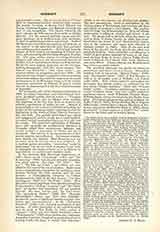

Germia, a titular see of Galatia Secunda, a suffragan of Pessinus; mentioned by Hierocles in the sixth century (Synec., 698, 4). About 650 it was already an autocephalous archdiocese directly dependent on Constantinople (Ecthesis pseudo-Epiihanii, ed. Gelzer, n. 51). Its condition was the same in the ninth century (Georgii Cyprii Descripto, ed. Gelzer, n. 51), under Emperor Leo the Wise (901-07) (ibid., n. 61); under Constantine Porphyrogenitus (ed. Gelzer, n. 59); and under Alexius I Comnenus after 1084 (ed. Parthey, n. 87). In the time of Michael Palieologus, about 1260, Germia must have been an autocephalous metropolitan see, such as it was still under Andronicus IT, about 1300, and under Andronicus III, about 1330 (ed. Gelzer, n. 80, 89). But the see was soon to disappear.
Lequien (Oriens christ., I, 495) knows of four titular Bishops of Germia. From the time of Justinian I (527-565) the city was entitled Myriangeloi, on account of a church dedicated to St. Michael and the Holy Angels. Justinian went there to take the baths in 556 (Theophanes, Chronographia, A.M. 6056). Today Germia is called Germa. It is a small village in the vilayet and caza of Angora, twenty-one miles southeast of Sivri-Hissar and twelve miles east of the ruins of Pessinus. The ancient baths and the ruins of the inn built by Justinian are still to be seen. Germia must not be confused with Germa, a suffragan see of Cyzicus in the province of the Hellespont, and later an autocephalous archdiocese.
S. VAILHÉ

